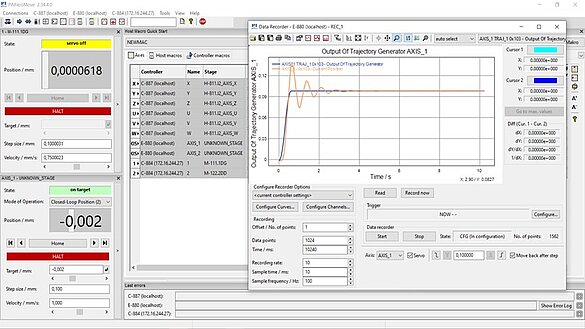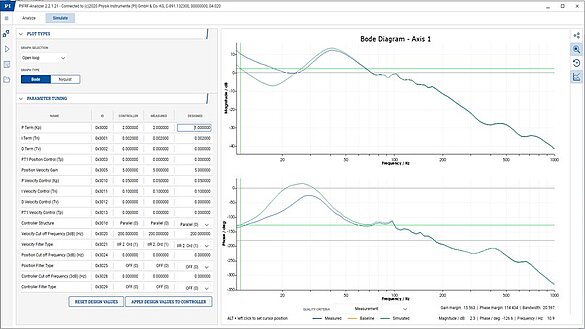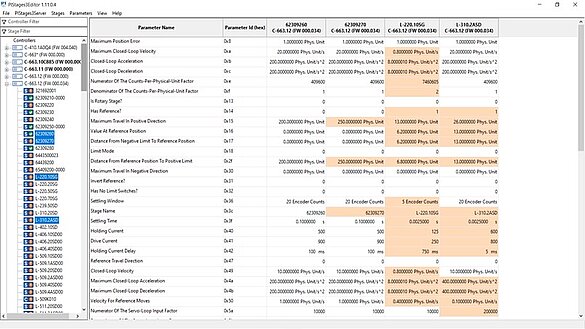Every PI controller is delivered with an extensive software package, the PI Software Suite. The delivered user programs support the user in setting up and parametrizing the overall system. For executing motion commands and additional optimizations, no additional programming effort is necessary. Intuitively operable user interfaces, graphic visualizations, and simple automation possibilities support a quick introduction and trouble-free usage.
PIMikroMove
PIMikroMove is our main software for interacting with all of our controllers. Many different tasks can be solved with this tool.
Independently of the drive principle or the number and configuration of the axes, all of PI's positioning systems can be controlled clearly and easily with PIMikroMove. All connected controllers and axes are displayed in the same consistent graphical interface. Several axes can be controlled using different controllers and commanded using PIMikroMove in the same window. By using the position pad, the motion of two or more independent axes can be controlled via the mouse or joystick, even in vector moves.
PIMikroMove – Selected Features
- Movement of the connected axes with various functions and options (step, open-loop/closed-loop, sine, trajectory, triggered...)
- Function generator for easy generation of user-defined motion profiles and synchronized operation of multiple axes
- Data recorder for saving and analyzing the system data
- Visualization of the position of the parallel kinematics
- Development and execution of GCS-based host macros in addition to the controllers' macro functionality with identical syntax and additional control commands. One macro can address any number of controllers
- Tuning tool for digital piezo controllers
- Parametrization and execution of host-PC-based 1D or 2D scans, and visualization of the results
- Parametrization and hand-over of alignment algorithms to the controller, as well as display of the evaluated data
- PITerminal (console) for interaction with the controller using GCS commands
The availability of some features can depend on the functionality of the controller.
Due to being integrated into PIMikroMove, the data recorder is an easy to operate tool for analyzing measurement data. It stores data from various data sources while displaying them as a function of time and offers a fast visualization.
All controllers have an internal data storage. This makes a precise storage of even very fast operations possible. The data sources and type of trigger can be configured and selected easily using the data recorder window in PIMikroMove.
Typical data sources are:
- Commanded and current position of the axis
- Commanded axis velocity and acceleration
- Motor output voltage per axis
- Status information
- Input voltage of the analog inputs
- System-relevant internal signal
The measurands recorded are immediately displayed in the data recorder window in PIMikroMove. Thanks to highly developed functions, a precise analysis and evaluation of the data can directly be carried out. In the integrated user dialog, an impulse can directly be commanded. The step response is recorded and represented graphically therefore allowing for a fast analysis of the system behavior and for the tuning of the positioning behavior.
Examples of integrated functions:
- Cursor and measurement functions
- Zoom functions allow the assessment of even the smallest signal motions
- Filter and analysis functions, such as FFT, algebra, derivatives, and statistics
- Customizable options for displaying data
- Export of recorded data in common data formats, such as *.csv
- Export as a graphics file and standardized printer outputs
With the Piezo Dynamic Tuner, the frequency and the step response of a system can be determined, and the settings for the servo parameters of the controller can be made. The user can set the control parameters and observe the respective system response. The type of system excitation and data recording can be configured to allow for an optimal characterization of the system. The Piezo Dynamic Tuner has various, powerful features for statistical analysis and determining the settling time as well as for importing and exporting the measured data.
By using the function generator, many controllers offer the possibility to store positioning values in internal tables and to run them once or cyclically in real time. With it, predefined forms of motion such as sinus, ramp, or sawtooth but also any user-defined trajectory points can be commanded. Examples of applications of this are: Analysis of the system's dynamic behavior, scans, shaker applications, etc.
PIFRF-Analyzer
The Frequency Response Function Analyzer (PIFRF-Analyzer) enables the definition and execution of measurements necessary for the dynamic characterization of a motion system.
Main features are:
- Open loop H0, closed loop HC, sensitivity S, inverse sensitivity/process sensitivity S-1, and plant H analysis
- Additional coherence analysis
- Different options for data visualization, including Nyquist plot
- Save & load transfer function for data comparison
- Simulation of the transfer function with modified controller parameters


